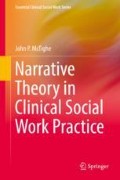Abstract
This chapter offers a review of the philosophical underpinnings and current state of narrative theory, as well as an introduction to social constructionism and its role in a narrative approach to clinical social work practice. An examination of the narrative structure of human experience leads to a discussion of the role of meaning making on individual, social, and cultural levels. The author presents a narrative perspective on social work practice as a particular way of listening to and engaging clients in the work of therapy.
Access this chapter
Tax calculation will be finalised at checkout
Purchases are for personal use only
References
Bamberg, M. (2004). Talk, small stories, and adolescent identities. Human Development, 47, 366–369.
Berger, P., & Luckmann, T. (1966). The social construction of reality. New York: Doubelday.
Bollas, C. (1987). The shadow of the object: Psychoanalyis of the unthought known. New York: Columbia University Press.
Bruner, J. (1986). Actual minds, possible worlds. Cambridge, MA: Harvard University Press.
Bruner, J. (1987). Life as narrative. Social Research, 54, 11–32.
Bruner, J. (1990). Acts of meaning. Cambridge, MA: Harvard University Press.
Bruner, J. (1991). The narrative construction of reality. Critical Inquiry, 18(1), 1–21.
Counselman, E. F. (2014). Containing and using powerful therapist reactions. In L. Motherwell & J. J. Shay (Eds.), Complex dilemmas in group therapy: Pathways to resolution (2nd ed., pp. 109–119). New York, NY: Routledge/Taylor & Francis Group.
Crossley, M. L. (2000). Narrative psychology, trauma and the study of self/identity. Theory & Psychology, 10(4), 527–546.
Crossley, M. L. (2003). Formulating narrative psychology: The limitations of contemporary social constructionism. Narrative Inquiry, 13(2), 287–300.
Freedman, J., & Combs, G. (1996). Narrative therapy: The social construction of preferred realities. New York: W.W. Norton.
Georgakopolou, A. (2006). Thinking big with small stories in narrative and identity analysis. Narrative Inquiry, 16(1), 122–130.
Gergen, K. J. (2015). An invitation to social construction (3rd ed.). Thousand Oaks, CA: Sage.
Howard, G. S. (1991). Culture tales: A narrative approach to thinking, cross-cultural psychology, and psychotherapy. American Psychologist, 46(3), 187–197.
Hyvarinen, M. (2010). Revisiting the narrative turns. Life Writing, 7(1), 69–82.
Josselson, R. (1995). Imagining the real: Empathy, narrative and the dialogic self. In R. Josselson & A. Lieblich (Eds.), Interpreting experience: The narrative study of lives. Thousand Oaks, CA: Sage.
Lia, M. (2017). Reflections, and relative examples, regarding countertransference, empathy, and observation. International Forum of Psychoanalysis, 26(2), 85–96. https://doi.org/10.1080/0803706X.2016.1200197
McTighe, J. P. (2015). Narratives of illness, difference, and personhood. In B. Probst (Ed.), Critical thinking in clinical assessment and diagnosis (pp. 171–188). New York: Springer.
Neimeyer, R. A. (1993). An appraisal of constructivist psychotherapies. Journal of Consulting and Clinical Psychology, 61(2), 221–234.
Neimeyer, R. A. (2005). Tragedy and transformation: Meaning reconstruction in the wake of traumatic loss. In S. Heilman (Ed.), Death, bereavement, and mourning. New Brunswick, NJ: Transaction Publishers.
Oelsner, R. (2013). Transference and countertransference today. New York, NY: Routledge/Taylor & Francis Group.
Polkinghorne, D. E. (1988). Narrative knowing and the human sciences. Albany, NY: State University of New York Press.
Riessman, C. K., & Quinney, L. (2005). Narrative in social work: A critical review. Qualitative Social Work, 4(4), 391–412.
Saari, C. (1991). The creation of meaning in clinical social work. New York: The Guilford Press.
Saleeby, D. (1994). Culture, theory, and narrative: The intersection of meanings in practice. Social Work, 39(4), 351–359.
Sarbin, T. R. (Ed.). (1986). Narrative psychology: The storied nature of human conduct. New York: Praeger.
Schafer, R. (1980). Narration in the psychoanalytic dialogue. Critical Inquiry, 7(1), 29–53.
Schafer, R. (1992). Retelling a life: Narrative and dialogue in psychoanalysis. New York: Basic Books.
Spence, D. P. (1982). Narrative truth and historical truth. New York: W.W. Norton.
Viderman, S. (2010). The role of the countertransference (1982). In D. Birksted-Breen, S. Flanders, & A. Gibeault (Eds.), Reading French psychoanalysis (pp. 210–217). New York, NY: Routledge/Taylor & Francis Group.
White, M. (2007). Maps of narrative practice. New York: W.W. Norton.
White, M., & Epston, D. (1990). Narrative means to therapeutic ends. New York: W.W. Norton.
Winnicott, D. W. (1971). Playing and reality. London: Tavistock Publications Ltd..
Wolstein, B. (1988). Essential papers on countertransference. New York, NY: New York University Press.
Author information
Authors and Affiliations
Rights and permissions
Copyright information
© 2018 Springer International Publishing AG
About this chapter
Cite this chapter
McTighe, J.P. (2018). Narrative Theory: An Introduction and Overview. In: Narrative Theory in Clinical Social Work Practice. Essential Clinical Social Work Series. Springer, Cham. https://doi.org/10.1007/978-3-319-70787-7_1
Download citation
DOI: https://doi.org/10.1007/978-3-319-70787-7_1
Published:
Publisher Name: Springer, Cham
Print ISBN: 978-3-319-70786-0
Online ISBN: 978-3-319-70787-7
eBook Packages: Social SciencesSocial Sciences (R0)

